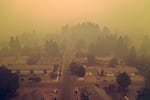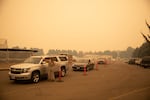
FILE: Stayton, Ore., blanketed with smoke on Sept. 10, 2020. Officials are urging Oregonians to prepare for heat, smoke and fires this summer.
Stephani Gordon / OPB
Wildfires burned more than 800,000 acres, a record-setting heat wave killed at least 96 people and smoke infiltrated the lungs of countless Oregonians during the summer of 2021.
As this summer approaches, experts and emergency officials are urging Oregonians to prepare for hotter weather, wildfires and smoke — even as a cool, wet spring delays their arrival.
“Knowing the things that we can do and taking care of it now is the best way to prepare yourself,” said Carrie Nyssen, senior director of advocacy for the American Lung Association.
Here are a few tips to stay safe:
Where can I find up-to-date fire information?
The National Interagency Fire Center keeps a running tally of active wildfires in each state. That tells you how many fires are active, how many are contained and how many are new.
For more detail, the National Wildfire Coordinating Group’s incident information system, known as InciWeb, is a regularly updated map of fires across the West. Public information officers post updates on specific fires along with photos and video.
The Oregon Smoke Blog also posts periodic updates about potential smoke hazards from fires burning in and out of state.
What if I need to evacuate?
Evacuation orders during a wildfire are handled by your local law enforcement agency or sheriff’s office. There are three levels of evacuation orders:
- Level 1: Get ready. This level means you should prepare yourself to evacuate and closely monitor fire activity.
- Level 2: Get set. This level means you need to be ready to leave at a moment’s notice.
- Level 3: Go. Leave the area immediately.
The state of Oregon recommends packing food and water, medicines, an emergency power source like batteries or wireless chargers, and important documents. The Federal Emergency Management Agency offers a longer list of items to pack in your go-bag in the case of evacuation.
People should be prepared to spend several days away from home at minimum.
How can I protect myself from wildfire smoke?
Whether a fire is at our doorstep or not, smoke has become a regular part of summers in the Northwest.
Nyssen with the American Lung Association said it’s important for people to monitor air quality during fire season.
The Oregon Department of Environmental Quality provides an online map and mobile app called OregonAir that display the air quality index. Third-party apps like Air Visual or government apps like AirNow from the U.S. Environmental Protection Agency can also provide helpful information about air quality.
In the absence of internet access, Nyssen said people can also use a simple sight or smell test.
“If we can smell our air and if we can see the air, those are likely indicators that the air quality is not good and is very likely unhealthy,” Nyssen said.
Wildfire smoke is mostly made up of small particles that, if inhaled, can cause damage to our respiratory system. The effects of wildfire smoke are especially harmful to people with asthma or chronic respiratory or cardiovascular diseases, as well as older adults, children, pregnant people and smokers.

FILE: Smoke from the Eagle Creek Fire in 2017 darkens the skies in downtown Portland.
Cassandra Profita/OPB / EarthFix
Public health agencies will often advise people to stay indoors if they can during periods of heavy smoke, but even then it’s important to take steps to keep indoor air clean.
“Air is air,” Nyssen said. “If we have our windows open or our doors are open, there’s nothing to stop the bad air from coming into our homes.”
People can keep their air cleaner by keeping doors and windows closed and making sure air conditioners, if they have them, are circulating indoor air with a clean filter. People should avoid burning candles, using gas stoves or vacuuming.
Air purifiers can also help clean indoor air, but supplies can run low during periods of high demand, so it’s a good idea to buy one before you need it.
For people who must be outside, it’s recommended you wear an N95 respirator approved by the National Institute of Occupational Safety and Health. The Oregon Occupational Safety and Health Administration offers guides on fitting masks in English and Spanish.
Oregon also recently adopted rules to protect outdoor workers from hazardous conditions like heat and smoke.
Where can I go to find clean air or stay cool?
Oregon is working to create more spaces for people to find refuge from poor air quality as well as extreme heat and cold.
The Oregon Department of Human Services recently received $7 million in funding to help build more cooling and warming shelters and clean-air sanctuaries in communities across the state.
“It’s filling critical gaps in local capability to ensure the best possible access to these public facilities when people need them,” said Ed Flick, director of DHS’ Office of Resilience and Emergency Management.

FILE: Evacuees of the Beachie Creek Fire gather at the Linn County fair grounds evacuation center in Albany, Ore., Sept. 8, 2020.
Bradley W. Parks / OPB
Local governments, public education providers, and tribal nations can apply for state assistance or equipment by notifying Oregon DHS. Flick said the department has already received dozens of applications. Funds will remain available through June 2023, or until they run out.
While construction of new cooling, warming and clean-air shelters may take time, DHS also has hundreds of available air-scrubbing machines to help service providers set up clean air stations.
“There’s a number of wonderful organizations that provide these services in communities now,” Flick said. “What we hope is that through the provisioning of this equipment is that the spaces will be better able to meet the needs of Oregonians.”
People can find more information about available cooling, warming or clean-air centers by calling 211 or visiting 211info.org.
